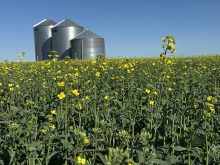Fewer cattle
The U.S. cattle herd is the smallest it has been since 1959, and the severity of the shrinkage surprised traders.
Chicago cattle futures rose Feb. 2 after the U.S. Department of Agriculture reported the total U.S. cattle supply was 94.49 million Jan.1, down from 96.03 million the year before. The average of trade estimates was 95.85 million.
The calf crop totalled 36.11 million, down from 36.76 million last year.
Fed cattle mixed
Steers averaged $86.86 per hundredweight last week, up 23 cents, while heifers averaged $87.16, down 30 cents, said Canfax.
Read Also

Huge Black Sea flax crop to provide stiff competition
Russia and Kazakhstan harvested huge flax crops and will be providing stiff competition in China and the EU.
Most of the trade took place Jan. 28 with steers $86-$87 live and $146-$148.80 rail; heifers traded $85.80-$86.10 and $147.85-$148.80 rail.
The basis narrowed because of the lower U.S. market, the higher Canadian dollar and the fairly steady domestic market. The cash to cash basis was $11 under compared to $16.18 under the week before.
About 17,000 head sold.
Fed cattle exports to the U.S. totalled 14,394 head compared to 12,124 the week before and 20,168 head a year ago.
Canfax said fed cattle supply is expected to be ample in February and price will largely be determined by box beef movement, packer inventories and the Canadian dollar.
With mandatory country-of-origin labelling (COOL) back in the comment period, it is likely that U.S. interest will be limited.
D1, 2 cows in Alberta were $34-$48 per cwt. with an average of $42.55, up 43 cents.
Butcher bulls were $40-$62, with an average of $52.32, up $1.59.
Slaughter cow and bull exports totalled 4,668 head two weeks ago, up from 3,830 the previous week and up from 3,317 last year.
U.S. beef drops
Beef demand has been seasonally light in January, Canfax said.
Choice fell $5.88 US to $143.77 while Select dropped $3.86 to $139.68.
The Canadian AAA cut-out value for 2008 averaged three percent lower than 2007 at $167 Cdn per cwt. while the AA cutout averaged one percent higher at $164, Canfax said.
Cut-out prices this year have been similar to 2007 levels and significantly higher than 2008 due to tight supplies, a lower dollar and buyers looking to fill mid-March features.
The Calgary and Montreal wholesale markets for delivery this week were steady at $154-$159 and $167 respectively.
Feeders rise
The feeder market saw feedlots looking to fill pen space and producers interested in grass cattle.
Alberta auction volume rose six percent to 34,606 head. That was up 62 percent from a year ago.
So far, auction volume is ahead 50 percent from last year.
Some producers who culled cows heavily this fall are opting to background grassers.
Yearling steers 800-900 pounds and heavier were $1-$1.60 per cwt. higher.
Yearling heifers 800-900 lb. and heavier were $1.10-$1.80 higher.
Steer calves 300-500 lb. traded 60 cents-$1.55 higher, while heifers 300-500 lb. were $1-$1.25 higher.
Overall, steers averaged $1.48 higher and heifers were up $1.30.
Feeder cattle exports totalled 10,401 head two weeks ago, up from 5,382 head the previous week but down from 11,630 head last year.
If the weather co-operates, auction volumes and prices should be steady.
Bred cows traded higher last week, while bred heifers were lower.
There is good to moderate demand for quality cows and heifers. The number of bred cattle on offer is still small, Canfax said.
Bred cows were $550-$950. Bred heifers $585-600.
Hog prices little changed
Packers continued to see negative margins on slaughter because of weak pork prices, but hog prices were fairly steady.
Iowa-southern Minnesota cash hogs edged slightly higher to $45.25 US per cwt. Jan. 30, up from to $44-$44.50 Jan. 23.
The U.S. pork carcass cut-out value fell to $56.94 Jan. 30 from $57.81 Jan. 23.
U.S. federal slaughter to Jan. 31 was estimated at 2.27 million, up from 2.24 million Jan. 24 and about steady with the year before.
Bison prices steady
The Canadian Bison Association said prices were mostly steady last week. Offerings are increasing seasonally.
Grade A carcasses from youthful bulls in the desirable weight range in Canada were $2.30-$2.80 Cdn, with an estimated average of $2.40 per lb. hot hanging weight.
Heifers were $2.20-$2.60 per lb. with an average of $2.30.
Cull cow and bull average rose to $1.05 per lb., with sales to $1.30.
Weight, quality and delivery location affect final price.
Sheep, lambs down
Beaver Hill Auction in Tofield, Alta., reported 603 sheep and lambs and 172 goats traded Jan. 26.
Sheep were down $10-$20 per cwt.
Buyers said trouble collecting on previous loads shipped to Ontario added to the price decline.
Lambs lighter than 70 lb. were $120-$148 per cwt.
Lambs 75-85 lb. were $128-$145.50, 86-105 lb. were $120-$139 and those heavier than 105 lb. were $115-$129.
Rams were $45-$57 per cwt. Ewes were $40-$55. Bred ewes were $50-$77.
Good kid goats were $105-$162.50.
Nannies were $40-$81 per cwt., bred nannies were $50-$103 and mature billies were $90-$110.
Ontario Stockyards reported 1,718 sheep and lambs and 71 goats traded Jan. 26.
Well finished light lambs were steady while medium and heavies were $10-$20 per cwt. lower. Good sheep were higher while common types were steady. Good goats were higher.
















